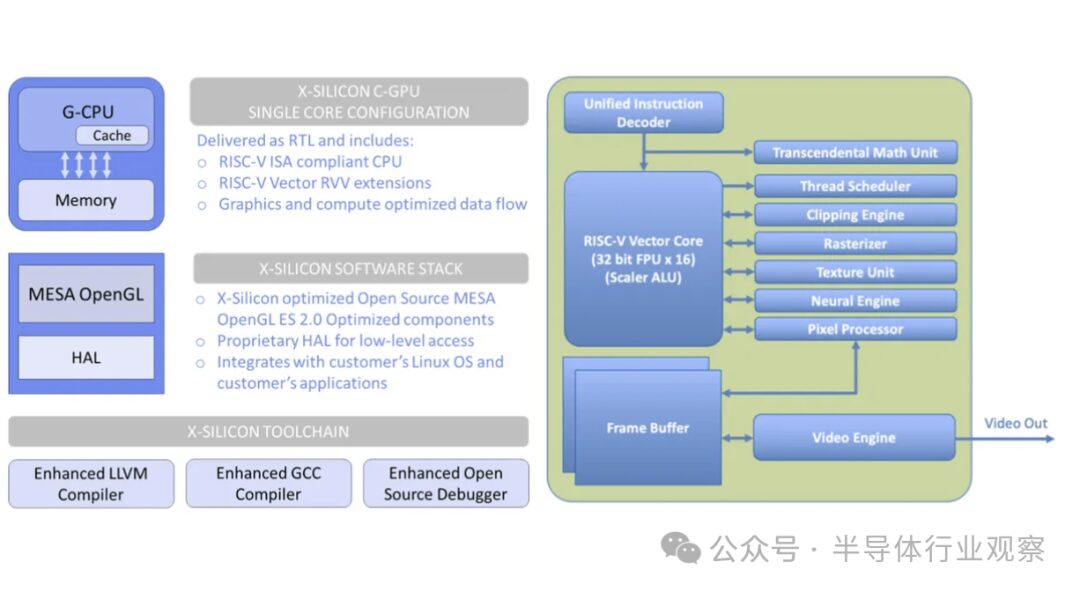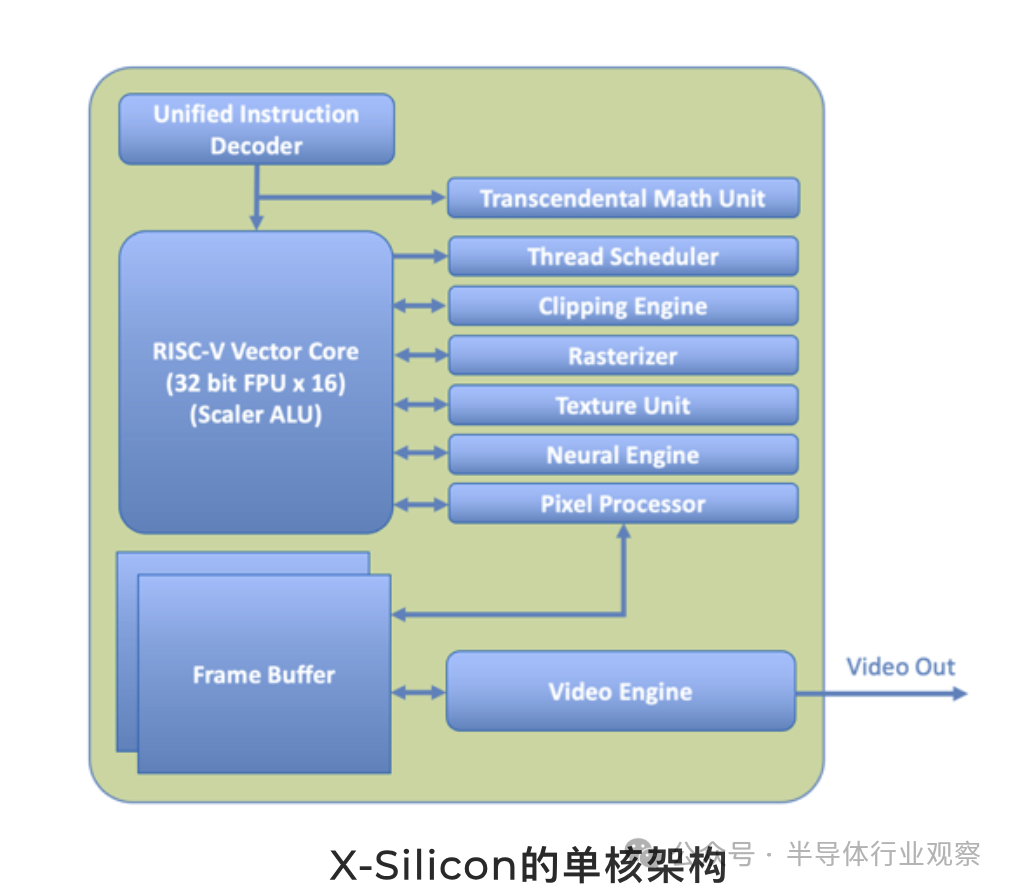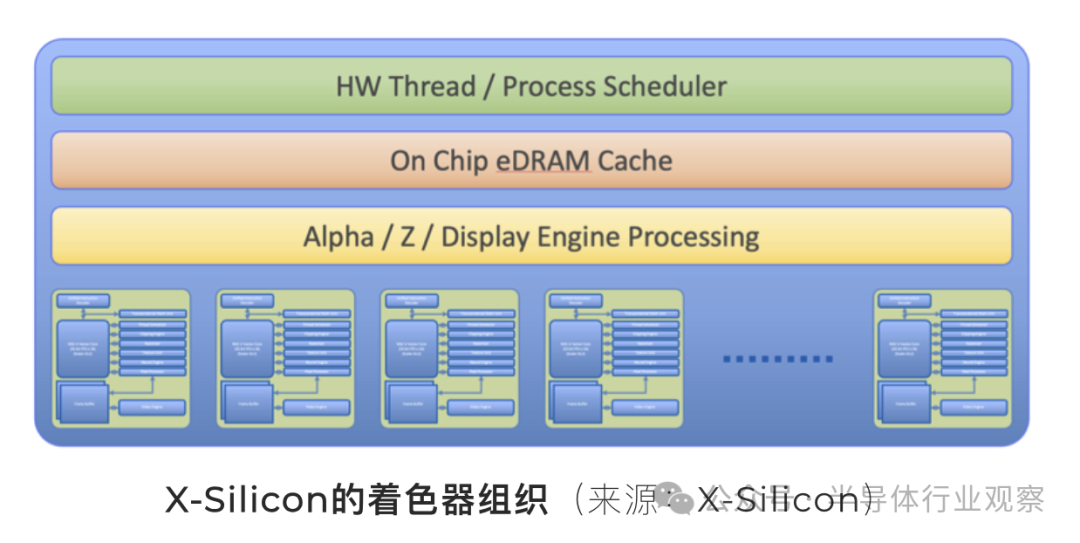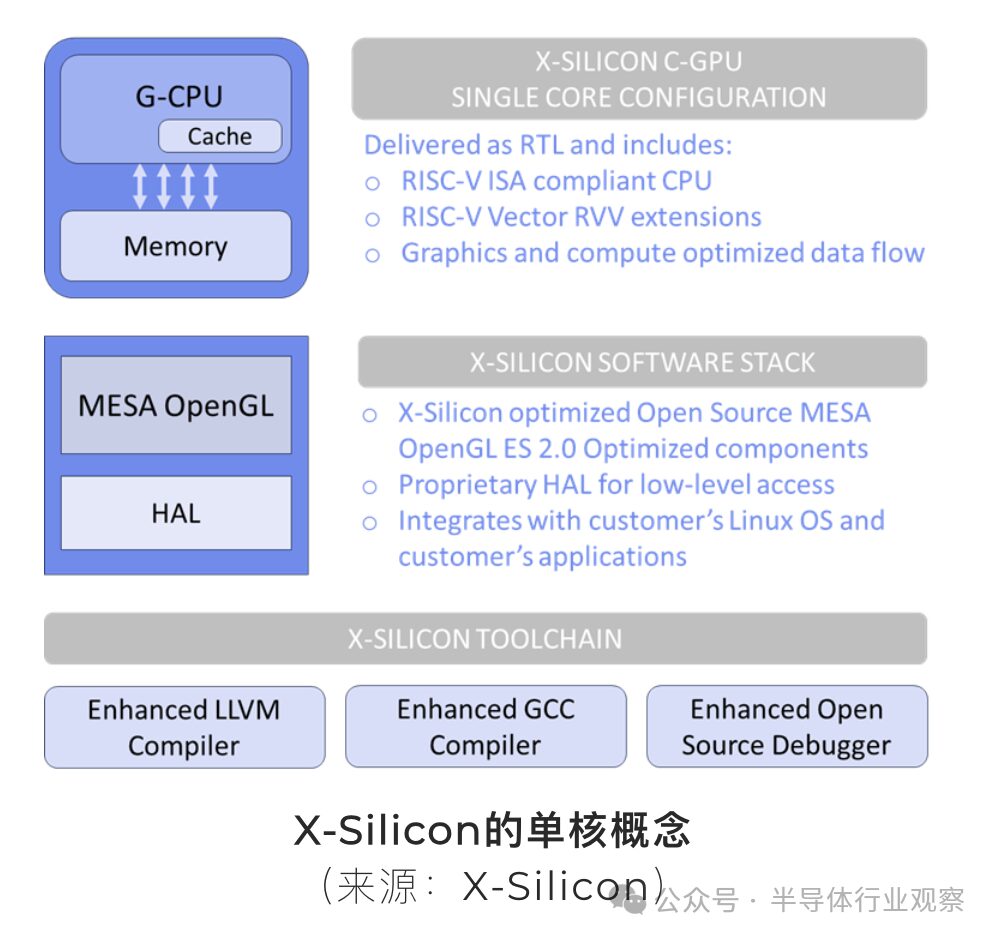X-Silicon Inc. (XSi) has created a new RISC-V microprocessor architecture that combines RISC-V CPU cores with vector capabilities and GPU acceleration into a single chip. According to Jon Peddie Research, the CPU/GPU hybrid chip is open-source and is designed to handle a variety of functions typically managed by dedicated CPUs and GPUs, aiming to do so more efficiently.
The new CPU/GPU hybrid processor is designed as a “universal” processor. According to JPR, the industry has been seeking an open standard GPU with the flexibility and scalability to support various markets, including virtual reality, automotive, and IoT devices. This new RISC-V CPU/GPU aims to solve this issue by providing manufacturers with a single open chip design capable of handling any required workload.
X-Silicon’s chip is different from other architectures as it integrates the functionalities of CPU and GPU into a single-core architecture. This contrasts with the typical designs of Intel and AMD, which have separate CPU and GPU cores. Instead, the core itself is designed to handle both CPU and GPU tasks. In this sense, it resembles Intel’s abandoned Larabee project, which attempted to use x86 to handle graphics and other workloads.
The chip adopts X-Silicon’s C-GPU architecture, integrating GPU acceleration into the RISC-V vector CPU core. This architecture features a RISC-V vector core with a 32-bit FPU and a scalar ALU. It includes a thread scheduler, clipping engine, rasterizer, texture units, neural engine, and pixel processors. The chip is designed to handle applications including artificial intelligence, high-performance computing (HPC), geometric computations, as well as 2D and 3D graphics.

Theoretically, X-Silicon’s hybrid chip can handle CPU and GPU code within the same core, bringing numerous advantages. The chip uses the open-source RISC-V ISA for both CPU and GPU, running a single instruction stream. This provides low memory overhead execution and higher efficiency, as there is no need to copy data between CPU and GPU memory spaces.
The CPU/GPU cores can be combined to form a multi-core design, allowing manufacturers to scale processing power as needed. In a multi-core format, multiple cores are tiled on a single chip and connected using a fast structure. This design also implements fast on-chip SRAM or eDRAM caches, which serve as L2 caches that can aggregate data from multiple cores. Each core can schedule graphics, AI, video, physics, HPC, or other workloads independently of the others as needed.
With this design, X-Silicon’s C-GPU architecture can run any type of CPU or GPU workload. X-Silicon claims to have Vulkan graphics API already compatible with “fusion GPU acceleration”. This will greatly assist in its development and adoption on Android devices.
Since the new design is based on RISC-V, anyone can use the architecture without paying instruction set royalties—unlike x86 and ARM. If it works as expected, these chips could shake up the microprocessor industry. Theoretically, the standard designs currently in use are not as flexible or powerful as X-Silicon claims.
While we may not have to wait long to find out, it remains to be seen whether it will be as effective in practice as it is on paper. Reports indicate that a software development kit will be released to early partners sometime this year.
X-Silicon’s Low-Power, Open-Standard, Vulkan-Supported C-GPU
X-Silicon Inc. (XSi) showcased its open-standard, low-power C-GPU architecture, combining GPU acceleration with RISC-V vector CPU cores and tightly coupled memory to form a low-power, single-processor solution. It is an open-source version of its unified RISC-V vector CPU-with-GPU ISA, providing register-level hardware access through a hardware abstraction layer (HAL). The NanoTile architecture in XSi C-GPU is designed to handle real-time data processing and dynamic graphics rendering, overcoming the limitations of traditional GPU architectures.

For over 20 years, the industry has been seeking an open standard GPU that is flexible and scalable enough to support various markets, including AR/VR, automotive, connected IoT, and a vast embedded vertical market including robotics. X-Silicon’s dynamic and highly scalable C-GPU NanoTile architecture, with its ability to handle multiple tasks simultaneously or sequentially, is unique in this regard.
X-Silicon Inc (XSi) is a startup based in San Diego, founded in March 2022, that has launched its latest innovation: an open-standard, low-power C-GPU architecture that integrates GPU acceleration into RISC-V vector CPU cores and tightly coupled memory, providing a low-power, single-processor solution. XSi’s approach introduces its unified RISC-V vector CPU-with-GPU ISA as open-source, offering register-level hardware access through a hardware abstraction layer (HAL). This allows original equipment manufacturers and content providers to customize drivers and applications through unusual customization, unlike competitors’ closed solutions. XSi believes that its pioneering adoption of Vulkan with fusion GPU acceleration on RISC-V facilitates development on Android devices, which is crucial for effectively addressing a diverse embedded vertical market.
XSi’s C-GPU utilizes the NanoTile architecture, which the company claims can meet the demands of real-time data processing and dynamic graphics rendering. Traditional GPU architectures struggle with dynamic data, necessitating a novel approach. XSi states that its processors are designed for optimal management and rendering of dynamic content, surpassing the limitations of traditional GPUs. By integrating AI/ML computation with GPU rendering, NanoTile ensures efficiency and adaptability, making it an ideal choice for advanced graphical algorithms.
The company holds 14 patents, claiming that its NanoTile architecture revolutionizes AI/ML computation and GPU rendering. These patents focus on optimizing data flow between processing cores and memory, reducing latency, and improving computational efficiency. Additionally, the patented IP of NanoTile can be deployed in edge and cloud configurations, fostering a collaborative model for GPU computing and providing flexibility and scalability.
XSi’s open-standard, low-power C-GPU architecture and NanoTile platform herald a paradigm shift in GPU technology. With support for open standards, customizable hardware access, and dynamic content rendering methods, XSi believes it will set new standards for GPU architectures, enabling developers and OEMs to unleash unprecedented levels of performance and efficiency in computational applications.
The company reports that the RISC-V ecosystem has responded positively to the launch of a new computing graphics company fully committed to advancing the open standard ecosystem.
The company plans to provide its software development kit to a select group of early development partners later this year.
Startup Introduces MIMD to Graphics and Computing
X-Silicon was founded by former Silicon Valley experts with the aim of revolutionizing GPU design through a unified graphics computing engine (C-GPU) based on RISC-V vectors capable of executing AI, HPC, and 2D/3D graphics tasks. Its MIMD architecture allows CPU and GPU code to be executed independently within a single core, reducing memory usage and enhancing performance. The company’s multi-core layout features a fast synthesizer structure that enhances data aggregation for different applications. X-Silicon seeks to reduce GPU latency through near-memory computing and novel hardware setups, supported by 14 patents. X-Silicon targets areas such as AR/VR, embedded devices, and automotive, supporting standard APIs and open programming for rapid development. Initial IP sales are aimed at OEMs and hyperscale vendors.
What’s our take? Some markets for new architectures have matured. The three giants have squeezed everything from traditional SIMD and added extra cores for things like matrix math (sometimes referred to as tensor cores), ray-tracing interference testing engines, codecs, and audio processors. X-Silicon believes it can meet many (if not all) of these dedicated processor needs with its tightly coupled block communication MIMD architecture. To this end, they will leverage the RISC-V ISA.
In 2022, a group of engineers, architects, programmers, and business developers from AMD, Qualcomm, Intel, ATI Technologies, Dell, and other companies were hard at work developing a new GPU design and realized they should name their company. As newcomers, they knew startups waste a lot of time trying to get a clever, memorable name and logo. So they chose X. It could be experimental, sexy, or unknown—hopefully all of the above.
To radically transform GPU shader cores, X-Silicon claims to be creating a new scalable RISC-V vector-based unified computing graphics engine (C-GPU) that can efficiently compute next-generation workloads that traditional GPUs cannot handle.
Such applications include artificial intelligence, high-performance computing, vision, geometric calculations, as well as 2D and 3D graphics. The company states that its MIMD architecture has a unique capability to run CPU and GPU code independently within the same core, enabling low memory overhead execution, hardware register bare-metal programming, high performance, low power operation, and the ability to replace using a single instruction stream, combining traditional shader programs with open-source RISC-V ISA suitable for both CPU and GPU.
In the company’s multi-core design, multiple C-GPU cores are tiled on a single chip and connected using an on-chip fast synthesizer structure, which can dynamically aggregate each core’s output into a common buffer, such as a framebuffer for graphics use cases or a pipeline buffer for codecs, video effects processing, and AI processing, as illustrated below.

In this design, fast on-chip SRAM or eDRAM caches will serve as secondary caches that can aggregate data from multiple cores. Common operations of computing RAM (C-RAM) are performed near memory, further reducing bandwidth and enhancing performance. The company claims that each core can be programmed to compute graphics, AI, video, physics, high-performance computing, or other workloads independently of all other cores.

Thus, workloads can be achieved in parallel or pipelined and run simultaneously on the cores rather than sequentially on traditional GPUs. X-Silicon states that it can also run operating systems on the cores.
The company claims it can also accelerate computing through near-memory computing, unified memory architecture, and other novel hardware configurations, thereby reducing the inherent latency of GPUs. They have applied for 14 patents for this purpose.
Eric Powers, a former Disney/Applied Minds/Giant AI animation industry expert, commented: “For decades, high-end animation and effects have struggled to switch to GPUs for generating final images. The enormous complexity and scale of professional rendering pipeline software, combined with dedicated GPU designs, have completely hindered the large-scale adoption of GPUs in our advanced technologies across memory and platform barriers. Integrated designs allow HPC developers to access direct hardware acceleration (such as X-Silicon’s C-GPU architecture) in place, which is the only future that leads us across this boundary.”
X-Silicon’s C-GPU provides OEMs looking to control their computing and GPU destiny with market opportunities for emerging use cases. It allows for new APIs (including custom APIs) and an ecosystem tailored for applications rather than forcing APIs to perform tasks they were never intended to perform. It no longer requires OEMs and manufacturers to yield to the stagnation of the ecosystem dominated by the five giants. The company believes its market opportunity lies in emerging markets such as entertainment and enterprise AR/VR with longer battery life, smart embedded devices with display demands, low-cost automotive displays and modules requiring predictable dedicated processing, wearables, custom animation processing, and more.

The company plans to support direct hardware and pixel access, so large drivers are not needed for low-memory applications. The company states that X-Silicon’s open-standard approach and its own open programming model will facilitate the rapid and easy development of new use cases and the improvement of existing products. Of course, X-Silicon also plans to support all APIs in the traditional software ecosystem, including OpenGL ES, Vulkan, Mesa, and OpenCL, but the company will also provide a hardware abstraction layer (HAL) that allows direct access for others to optimize open-source or create their own drivers and custom APIs. This is particularly interesting as the architecture supports emerging technologies, including new rendering models not supported by traditional architectures, such as neural radiance fields (NeRF) and non-triangle primitives.
The company plans to first sell IP to OEMs, hyperscale vendors, and other system integrators. No release date has been given for the first silicon.
X-Silicon integrates CPU and GPU (C-GPU) with a single ISA and an open graphics operating system (GOS) platform, which can have profound implications for the overall software development, support, and maintenance of next-generation graphics rendering. This could usher in an exciting era of innovation in the graphics field, providing new graphical algorithms, performance, power consumption, flexibility, and cost approaches for both emerging and traditional market segments. This approach fundamentally transforms the graphics world, freeing OEMs from the shackles of traditional GPU vendors that offer black-box drivers with complex APIs and expensive traditional support.
Traditional GPU SIMD architectures are constrained by host CPUs, operating systems, and graphics services, limiting innovation and helping maintain existing enterprises’ control over their markets. New, emerging, smaller vertical markets, often underserved by these traditional graphics vendors, can develop and support compelling graphics solutions that can be upgraded and maintained throughout the product lifecycle. Next-generation products using new display technologies, new formats, and usage scenarios (VR/AR, 360, depth, stereo, multi-plane holography) often require a new rendering approach. New development and deployment paradigms also need a consistent architecture that can scale from edge to cloud.
X-Silicon is not just an open-source alternative to traditional GPU vendors; it is also prepared to provide a new technological graphics processing framework that integrates the latest artificial intelligence and transcends triangle-based rendering to deliver an innovative platform for graphics unseen since the early 2000s on mobile devices.
Reference Links
https://www.tomshardware.com/pc-components/cpus/former-silicon-valley-vets-create-risc-v-microprocessor-that-can-run-cpu-gpu-and-npu-workloads-simultaneously
https://www.x-silicon.com/news/
https://www.jonpeddie.com/news/x-silicons-low-power-open-standard-vulkan-enabled-c-gpu/


☞ Business Cooperation: ☏ Please call 010-82306118 / ✐ Or send to [email protected]


Click here to “Read the original text”, directly to the official website of Electronic Technology Application